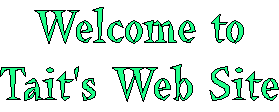| |
TWiki Shorthand Basics
If you can enter text, you're ready for TWiki. With a few simple, intuitive TextFormattingRules, you'll be able to use plain text to create well-styled postings, instantly. Here's a fast-track guide to shorthand basics...
- Separate each paragraph with a blank line.
- To display a word or phrase in bold type, put it in asterisks:
*bold type*.
- To display a word or phrase in italic, put it in underscores:
_italic_.
- To display a word or phrase in bold italic, put it in double underscores:
__bold italic__.
- To link to another Wiki topic, type the WikiWord for that topic. To link to a Wiki topic in another web, type the name of the web, and a dot, first:
Sandbox.WebHome.
- If you enter a WikiWord for a topic that doesn't exist, it'll appear highlighted with a red-link, prompting you (or someone else) to start off the new topic by clicking the link - NewTopic (click the link, but don't save, to preserve the example!).
- When entering WikiName signatures - like, guest - include "Main." as a prefix, since all TWiki member pages are in the Main web:
Main.YourName.
- For an external link, type the full URL:
http://twiki.org/.
- To prevent a WikiWord from becoming a link, type
<nop> or an exclamation point first: <nop>NoLinkPlease or !NoLinkPlease.
- To indent with a bullet, enter
[space][space][space][asterisk][space].
- Use multiples of 3 spaces to start nested bullets.
- To create a numbered list:
- Start items in a numbered list with
[space][space][space][1][space].
- The "1" (or any number) will be replaced by the correct number, in order.
- To add a new paragraph without restarting list numbering, use the %BR% variable, like below:
Text added (in new paragraph)
- and list numbering continues.
- Always start counting spaces for bullets and such from the beginning of a new line.
- To include an image, type its URL. You also can Attach an image to the page and display it with text
%ATTACHURL%/yourimagefilename.jpg
- To display a word or phrase in
MONOSPACED TYPE, put it in equal signs: =like this=.
Use ==two== for bold: bold mono.
- Use
<verbatim> to enclose code excerpts, filenames, and other unformatted text:
<verbatim>
unformatted text!
</verbatim>
 NOTE: VARIABLES can be set within verbatim tags, that is, they are not disabled NOTE: VARIABLES can be set within verbatim tags, that is, they are not disabled
- Use
<literal> to enclose anything that TWiki must not touch under any circumstances, such as in-line HTML code.
- Follow GoodStyle recommendations when editing topics.
- See TextFormattingRules for the complete set of formatting rules.
Related topics: WikiSyntaxSummary, WikiWord, WikiNotation, TextFormattingRules, TWikiEditingShorthand, TWikiRenderingShortcut, TWikiShorthand |





